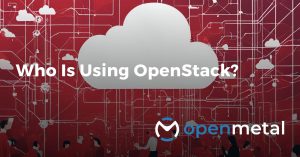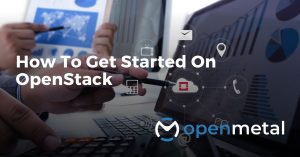
In this article
- Who Is Using OpenStack?
- What Is OpenStack?
- Questions You May Have About OpenStack
- Examples of Organizations That Are Currently Using OpenStack
What Is OpenStack?
Now that you’ve seen the impressive list of organizations that have put their faith in OpenStack, let’s take a closer look at what OpenStack is before diving into the details of how each organization uses it in their infrastructure.
OpenStack is a collection of open source software projects for creating and managing cloud infrastructure. OpenStack was designed to provide flexibility and scalability when deploying and managing cloud resources. This makes OpenStack suitable for a variety of use cases from small private clouds to large-scale public cloud environments.
Additionally, because the code for OpenStack projects is open source, users are able to make root level configurations to secure, optimize, customize and integrate their cloud. OpenStack may be the most popular open source cloud infrastructure software but it’s nowhere near the fame of AWS and GCP.
Questions You May Have About OpenStack
Why Did OpenStack Fail?
Short answer, it didn’t! It is one of the most heavily developed software system online and currently automates over 40 million CPU cores – more on OpenStack here.
The biggest obstacle that OpenStack had to overcome was complexity. This is a problem that you will encounter anytime you try to build your own cloud and are responsible for configuring, fine tuning, securing, and maintaining your cloud.
The success of AWS and GCP comes from the fact that they do this for you. But choosing to use an open source cloud like OpenStack does not mean that you need to be responsible for this either. There are OpenStack providers like us that will do the heavy lifting for you. Users their own private OpenStack cloud that can be used for any purpose, including selling resources like VMs, VPCs, storage, and more as your own hosting company or public cloud provider.
This plus the added ability to integrate with Kubernetes has led to more users turning to OpenStack than ever. Again, there are more than 40 million cores in production. If you ask me that’s far from failing! While OpenStack is not as well known to the general population, it is the most popular open source cloud software and as an aggregate it is ready to be an alternative to public clouds like AWS, GCP, and more.
Does NASA use OpenStack?
Yes! Not only does NASA use OpenStack, in fact NASA helped developed OpenStack. NASA developed the OpenStack project Nova, the project which allows you to quickly access compute resources (bare metal, virtual machines, and containers). NASA has various departments using OpenStack as part of their entire cloud infrastructure and their current OpenStack deployment is a combination of on-prem and hosted OpenStack. You can learn more about NASA’s OpenStack deployment here.
Who is behind OpenStack?
OpenStack was founded in 2010 through a collaborative effort between NASA and RackSpace. Currently, OpenStack is governed by the Open Infrastructure Foundation which has over 110,000 members in 187 countries. The objective of the Open Infrastructure Foundation is to build open source communities that write software that runs in production. 100,000+ members working to continuously test and improve OpenStack for over a decade allowed this open source software to not only evolve into something that is truly reliable, but made it feasible for OpenStack to be updated consistently to keep up with modern needs.
Is OpenStack free to use?
Yes, OpenStack is open source software and is generally free to use. Being open source means that the source code is freely available, and users have the freedom to modify, distribute, and use the software as per the terms of the open source license.
However, while the OpenStack software itself is free, there may be costs associated with deploying and managing an OpenStack infrastructure. These costs can include hardware, networking equipment, personnel training, and ongoing operational expenses. Organizations may choose to deploy and manage OpenStack on their own infrastructure or use the services of a managed service provider.
Examples of Organizations That Are Currently Using OpenStack
Government Agencies

Some may find it surprising that OpenStack is used by government organizations. Government organizations are notorious for strict security compliance and red-tape but we should remember NASA helped birth OpenStack and still uses it today. In addition to NASA, other government organizations such as France’s Interior Ministry and the US Civil Service also use OpenStack.
NASA: NASA currently has over 9000 OpenStack cores in production. How do they have this much trust in an open source software? NASA developed the OpenStack component called Nova – one of two components that OpenStack was founded with. NASA needed a scalable infrastructure that could process massive amount of data for their space missions. And this is what lead to the development of Nova which they contributed to the open source community in order to foster innovation and collaboration to address the complex technological difficulties.
Today NASA uses OpenStack clouds at:
–NASA Center for Climate Simulations (NCCS): two very different OpenStack cloud environments a PaaS (focused on science) and IaaS (focused on engineering) with 9000 cores and 322 teraflops of computing power. They use Ansible to manage the OpenStack Control Plane and Hypervisors, with integration with NASA identity management tools. Learn more here.
–Jet Propulsion Laboratory (JPL): This lab supports mission-critical data for JPL’s robotic probes and Mars rovers. They have been using OpenStack since 2016.
–Langley Research Center: Here they use OpenShift for developing and deploying cloud-native applications.
Lockheed Martin: a major American aerospace, arms, defense, information security and technology corporation. Lockheed Martin has more than 115,000 employees worldwide and their products and services are crucial for national defense and homeland security. Lockheed Martin also uses OpenStack clouds, most recently to test the flight software for the Orion space capsule which completed an unmanned flight to the moon and back to Earth. This was part of the Artemis 1 mission and will happen again with the Artemis II mission in 2025. The Artemis project will land the first woman and person of color on the moon. It is intended to establish a long term presence on the moon to facilitate journeys to Mars. Lockheed Martin hosted the stimulation in a private OpenStack cloud as they needed a secure and efficient IT environment. Learn more about Lockheed Martin’s use of OpenStack for lunar mission in this article here.
France’s Interior Ministry: started using OpenStack in 2014. There are two key applications they use their OpenStack clouds for:
-ASILE platform which handles the entire asylum application process, this platform also integrates with other databases and document management systems.
-ET GOA platform this platform allows user to access the drivers license tests online.
There are plans to move 150 applications to OpenStack over the course of the next few years.
UK Civil Service: The UK government is recognized as one of the world’s most digitally advanced in the world by the UN in their August 2016 United Nations E-Government Survey. The government keeps an ambitious technology agenda. Spire, the UK’s legacy system, makes it easier for multiple offices (ex. Dept for International Trade, Ministry of Defence, HM Revenue and Customs, etc.) to collaboratively work on and sign off on imports and exports.
Finance & Banking

Finance and banking is another example where you may expect decision makers to shy away from OpenStack. But despite the public misconception that OpenStack is inadequate in some ways, users in all industries at enjoying the benefits of this open source cloud. And we’re not just talking about any banks, these are some big names that you will recognize.
Santander: This massive Spanish bank uses OpenStack for big data workloads. Santander bank has over 16 million customers and accommodates approximately 45 million online transactions annually. Using OpenStack, they have been able to cost effectively accommodate the needs of their customers by scaling resources when needed. Santander Bank uses OpenStack on-premise, giving them total control over their infrastructure and security. They have a team of OpenStack experts which allows Santander bank to use OpenStack to run complex fraud detection algorithms in real time and build advanced risk detection models to effectively manage financial risks.
Bloomberg: While it may be questionable if Bloomberg should fall under Finance or Media, they provide real time financial data, analytics, and trading tools through their terminal in addition to global news. The Bloomberg terminal has over 300,000 subscribers and Bloomberg news has millions of readers worldwide. Bloomberg built their own private clouds using OpenStack, choosing private clouds due to security and compliance obligations. They also liked that with private cloud they were able to tailor their capabilities to meet the demands of the marketplace.
In the financial services industry, there is a high need for low latency, with private OpenStack clouds they were able to control their network, the latency of their data, bandwidth, etc. Bloomberg used OpenStack to build their own OpenStack distribution called Bloomberg Clustered Private Cloud (BCPC). Bloomberg began their OpenStack journey with Folsom. Bloomberg has used OpenStack for many years and has more than 11 clusters across 3 data centers with 3000+ instances and 8000+ vCPUs. Learn more about Bloomberg’s use of OpenStack here.
Retailers
 Retail is probably the most expected use case of OpenStack. Major retailers tend to be strategic when considering their cloud infrastructure choices. Retailers such as Walmart, Target or OverStock consciously opt to avoid Amazon Web Service to avoid being dependent on a platform owned by a direct competitor (Amazon). They instead prefer alternative cloud solutions that offer comparable, if not superior, scalability, reliability, and security features.
Retail is probably the most expected use case of OpenStack. Major retailers tend to be strategic when considering their cloud infrastructure choices. Retailers such as Walmart, Target or OverStock consciously opt to avoid Amazon Web Service to avoid being dependent on a platform owned by a direct competitor (Amazon). They instead prefer alternative cloud solutions that offer comparable, if not superior, scalability, reliability, and security features.
Major retailers with a strong online presence need to provide user-friendly websites and apps. Organizations with the technical expertise on hand choose OpenStack as the open source nature grants them unlimited access to the the code which allows fine tuning of their infrastructure to meet the unique IT requirements of retail operations, including the demand for high customization, control over infrastructure, and low-latency responses for seamless customer experiences.
Overstock: Overstock’s infrastructure needs to be highly scalable to provide a seamless experience to the missions of customers who visit their website everyday. To accommodate fluctuating demanding throughout the day and peaks during sales without overspending, their infrastructure needs to be able to scale up and down easily. This is one of the strong suits of OpenStack.
Overstock started using OpenStack around 2012/2013 with the Folsom release. They run more than 800 applications across 5 OpenStack clouds. According to Mike Smith, a cloud architect at Overstock.com, most of their production infrastructure is virtual and running on OpenStack infrastructure. Overstock uses “Elastigirl” – a configuration which implements OpenStack Ceilometer with Gnocchi to provide monitoring and scaling of their cloud workloads. Using Ceilometer, when there are spikes in traffic, you can identify the cause of the spike and then mitigate. This is crucial for organizations that have many different teams or workloads running on OpenStack. It allows them to quickly adjust and accommodate spikes in demand, which will provide their consumers with a seamless experience.
A lagging website when you’re trying to check out a low inventory item when there’s a huge sale can be a stressful experience to customers and if the inventory runs out before you’re able to complete the check our process, your customers will be disappointed and feel like they wasted their time and energy for nothing. This is not the customer experience you want to provide to your customers. You can learn more about Overstock’s use of OpenStack here.
Target: Target has 1950 stores across the United States and caters to millions of visitors each day on their website. When looking at the U.S retail e-commerce category, target.com is ranked 5th for the most visited website. The retail industry is very competitive especially when you’re up against giants such as Amazon and Walmart. So Target places importance on innovation in their stores, online, and in their apps. To do this Target has adopted open source broadly, everything they do uses API and OpenStack allows them to do so.
In 2015, Target started using OpenStack Icehouse with Ceph storage, they added their first OpenStack cloud to their existing cloud infrastructure as an experiment. This was for development purposes and back end applications, but after experiencing the power of OpenStack, Target quickly expanded their team of OpenStack engineers and their OpenStack environment now has more than 32,000 cores. Target has used more than 750,000 VMs on OpenStack since their initial deployment across development and production and keeps active roughly 13,000 VMs. For storage they started with HDDs but had a better experience when they upgraded to SSD. Ceph is used for both block and object storage.
You can learn more about OpenStack Architecture and Deployment at Target here.
Walmart: Walmart has over 11,000 stores in 28 countries around the world, selling everything from bananas to computers. They also have a massive online presence where they serve 80 million visitors monthly.
How does Walmart provide a seamless experience to their online customers? With OpenStack, the “company has more than 170,000 cores running on OpenStack”. This incredible OpenStack deployment was accomplished by WalmartLabs that was founded in 2011 and employs over 3600 employees. Walmart developed its own open source cloud management platform called OneOps. It’s important to note that OneOps is not a cloud in itself but rather serves the purpose of managing applications and infrastructure across various providers.
WalMartLabs has fully immersed itself in the open source culture with their engineers contributing to the constant evolution of OpenStack. In 2016 they made their OneOps cloud management platform open source and even considered making it an OpenStack project to bring “its application life cycle and orchestration features to OpenStack itself.” Learn more about how Walmart uses OpenStack here.
Telecommunication Organizations
 Many telecommunications organizations around the world have incorporated OpenStack into their cloud infrastructure models. One of the main reasons for this is that having complete control of the infrastructure and the network allows telco providers to customize the experience of their users. If you ever felt that your data slowed after using a certain amount, that’s because sometimes they cap your unlimited 5g to be a bit slower after you use a certain amount to keep your use within the budget of your bill. If your Telco provider used public cloud where it’s already so easy to overuse resources and didn’t put a cap on usage, imagine the bills they would rack up from their millions of users. Many telco companies run Kubernetes workloads on OpenStack to get a very powerful, yet cost effective infrastructure to support their workloads and customers. Let’s look at a few telco organizations running workloads on OpenStack.
Many telecommunications organizations around the world have incorporated OpenStack into their cloud infrastructure models. One of the main reasons for this is that having complete control of the infrastructure and the network allows telco providers to customize the experience of their users. If you ever felt that your data slowed after using a certain amount, that’s because sometimes they cap your unlimited 5g to be a bit slower after you use a certain amount to keep your use within the budget of your bill. If your Telco provider used public cloud where it’s already so easy to overuse resources and didn’t put a cap on usage, imagine the bills they would rack up from their millions of users. Many telco companies run Kubernetes workloads on OpenStack to get a very powerful, yet cost effective infrastructure to support their workloads and customers. Let’s look at a few telco organizations running workloads on OpenStack.
China Mobile: China Mobile is the world’s largest telecommunication company, with over 835 million subscribers and more than 3 million stations, the workloads hosted by China Mobile are massive.
China Mobile needed a cost effective and robust infrastructure to accommodate the high demand they receive from their subscribers. They built an impressive cloud infrastructure and OpenStack plays in key role in the architecture of their public cloud. They even have a thousand-node OpenStack cluster. China Mobile has one of the world’s largest NFV networks based on OpenStack with more than 50,000 servers in the network.
If you were hesitant about OpenStack’s ability to handle your workloads as your organization expands and your infrastructure needs increase, this use case should put all of your worries at ease. One of the biggest pros of using OpenStack is its scalability. OpenStack allows for horizontal scaling which allows you to easily add and remove compute, storage, and networking resources as needed.
Deutsche Telekom: one of the world’s leading telco companies with 178 million customers, 28 million fixed network lines, and 20 million broadband lines. Their product Open Telekom Cloud is a large scale public OpenStack Powered Platform. They were one of the first major European companies to publicly support the OpenStack project with activities dating back to 2012.
Verizon: uses OpenStack components as the basis for their platform used to create their Network as a Service solution. VNS is composed of a range of services within a versatile framework on x86 hardware which allows customers to choose the services, network architecture, and delivery models that best suit their needs. Verizon also uses OpenStack as the foundation of their VCP (Verizon Private Cloud Platform). This is a globally distributed platform that’s run from multiple (30+) data centers globally, but with the core data center in the US. This cloud platform is regionally distributed to limit their failure domain.
Technology
Many technology companies are inclined to use open source software as access to the code allows them the control over their infrastructure they prefer.
Convesio is the first self-healing, autoscaling platform-as-a-service for creating and managing WordPress websites. Convesio specializes in helping mission-critical business websites, including eCommerce, membership, publication, or online learning management sites (LMS), that are susceptible to web traffic spikes. This can happen when large news sites break an important story. eCommerce sites often have flash sales. Online schools can have thousands of students logging into and/or taking a class all at once. When this happens, Convesio scales resources to achieve the highest speed and performance available.
Convesio turned to OpenStack after facing outrageous costs, lackluster support and inflexibility from AWS and GCP. They wanted to stand out and deliver exceptional performance to their customer, a task that seems impossible when using the same infrastructure as your competitors. Convesio turned to OpenStack clouds provided by OpenMetal, this partnership allowed them access to their cloud infrastructure to customize for optimal performance and reduce their public cloud costs my more than 50%.
You can learn more about Convesio’s journey from public cloud to hosted OpenStack clouds here.
OpenMetal provides the world’s first on-demand OpenStack private cloud platform and automated bare metal. Launch a production-ready cloud in just 45 seconds – without the expensive hardware investment or steep learning curve. We provide an open source alternative with lower costs, more transparency and control, and greater flexibility, all tailored to your unique needs. But we don’t just provide OpenStack clouds, we use OpenStack for both our production and developmental workloads.
OpenMetal leverages OpenStack to run multiple Kubernetes instances, providing a robust and scalable infrastructure for our operations. We utilize Velero for automatic backups, which take snapshots of our OpenStack volumes and save our configurations in object storage. Our GitHub Actions are executed on self-hosted runners within the pods of our Kubernetes clusters, ensuring efficient and secure CI/CD workflows. Additionally, our development environments are hosted on a Kubernetes cluster within OpenStack, enabling seamless integration and consistency across our development and production environments
How To Get Started On OpenStack
On-Demand OpenStack Clouds by OpenMetal deploy in under 1 minute. Each private cloud core is a hyper-converged set of 3 hosted servers. OpenMetal cloud cores are set up using Kolla-Ansible and Ceph-Ansible, but users have root ownership to customize their clouds as they need. OpenMetal offers complimentary access for testing our production-ready private cloud infrastructure prior to making a purchase.
Complimentary Private Cloud Trial >> On-Demand OpenStack
You can also access our complete library of OpenStack training resources here. This library includes: guides, tutorial videos by FreeCodeCamp and LearnLinuxTv, and blogs.
For more examples of organizations using OpenStack, check out the Use-Case page on OpenStack’s website.
More on the OpenMetal Blog…

Leveraging On-Demand Private Clouds: A Guide for CTOs
Explore this comprehensive guide on how Chief Technology Officers (CTOs) and technical executives can harness the power of on-demand private clouds for their organizations. In ….Read More

How To Get Started On OpenStack
If you are tired of unpredictable public cloud bills or want more control over your infrastructure, you may be considering migrating workloads to an OpenStack cloud. Private OpenStack clouds are increasing …Read More

AWS vs GCP: Choosing the Right Cloud Platform
AWS and GCP are leading players in cloud computing, offering a wide range of services and attractive pricing. However, choosing the right platform requires understanding their strengths … Read More
Test Drive
For eligible organizations, individuals, and Open Source Partners, Private Cloud Cores are free to trial. Apply today to qualify.
Subscribe
Join our community! Subscribe to our newsletter to get the latest company news, product releases, updates from partners, and more.



































